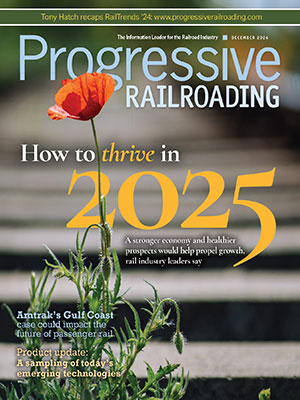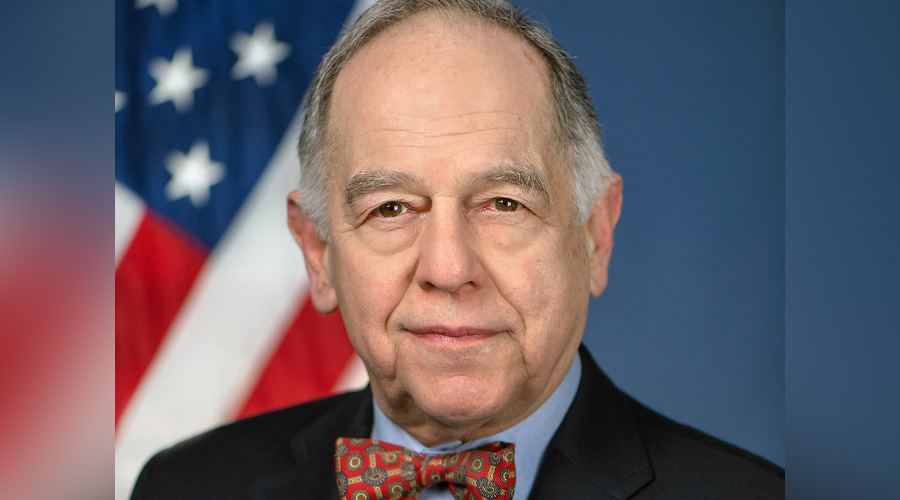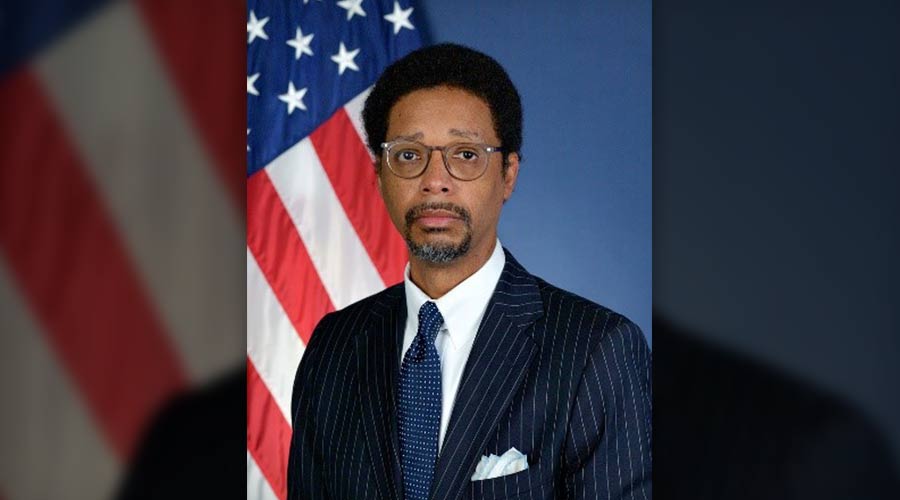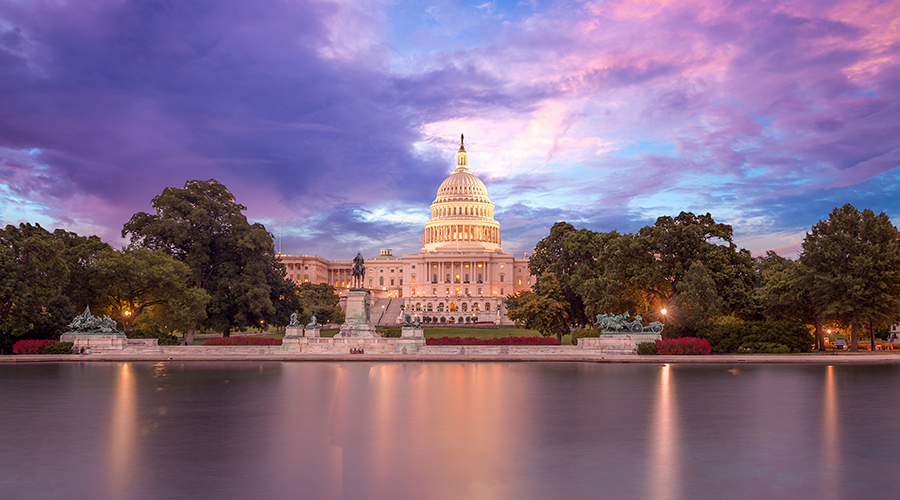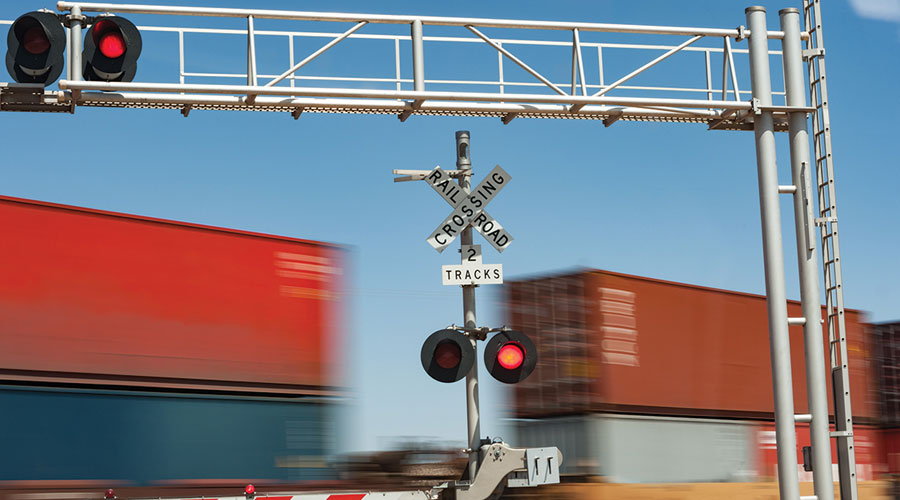Stay updated on news, articles and information for the rail industry
February 2020
Rail News: Federal Legislation & Regulation
FAST Act reauthorization, crossing safety top policy priorities for rail
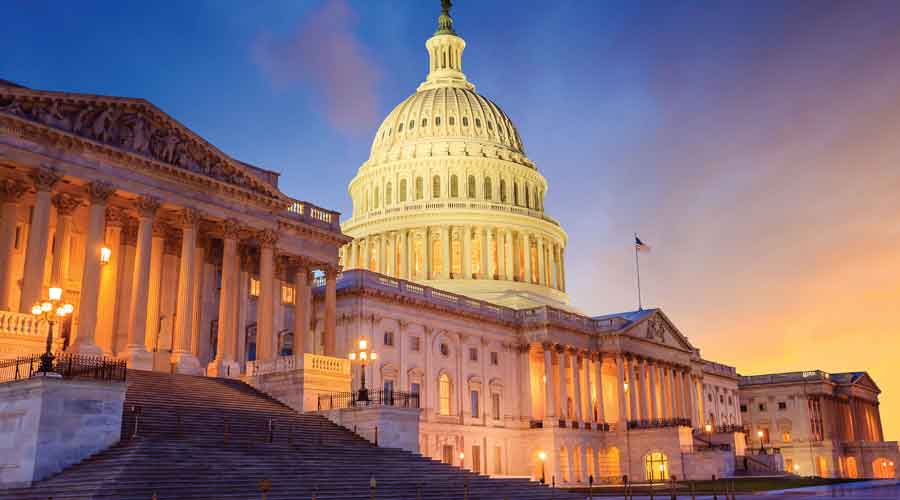
By Julie Sneider, Senior Associate Editor
With 2020 being a presidential election year, it wouldn’t be farfetched to believe that no substantial bills on infrastructure will get through Congress before lawmakers break for presidential campaign season later this year.
Still, folks in the rail realm who spend much of their time on Capitol Hill are cautiously optimistic about the potential for enacting key legislation. One thing that may be raising their hopes is a significant legislative victory for railroads and rail suppliers that occurred in the final hours of 2019: the passage of a five-year extension of the short-line tax credit known by its tax line item reference Section 45G.
In late December, Congress passed and President Donald Trump signed two major appropriations bills that included a number of measures of interest to the rail industry. One of those bills (H.R. 1865) included a measure that made the 45G tax credit retroactive to 2018 and effective through 2022.
First enacted in 2005, the tax credit has helped short lines invest more than $4 billion in infrastructure rehabilitation projects. Extended by bipartisan votes on six occasions prior to the congressional action late last year, the most recent extension expired at 2017’s end.

American Short Line and Regional Railroad Association (ASLRRA) President Chuck Baker says passage of this latest 45G extension was one of the “better moments” of his career. As the association’s president for the past year, as well as in his previous leadership roles at the National Railroad Construction & Maintenance Association (NRC), Baker has spent a good portion of his career advocating for a long-term — if not permanent — extension of 45G.
“I’m still over the moon about it,” Baker says. “The passage of the 45G extension was a huge moment for us. We’ve been working so hard on this issue.”
But ASLRRA and other rail groups that touted the extension — including the NRC, the Railway Supply Institute (RSI), Railway Engineering-Maintenance Suppliers Association (REMSA) and Association of American Railroads (AAR) — don’t plan to rest on their legislative laurels. They’ll now turn their attention to pushing for a permanent extension of the tax credit, possibly as part of legislation that will reauthorize the Fixing America’s Surface Transportation (FAST) Act, which is set to expire Sept. 30.
A wishlist for reauthorization
Overall, surface transportation reauthorization is their top legislative agenda item on Capitol Hill this year, rail industry advocates say. And they’re hopeful that FAST Act reauthorization will address several priorities aimed at strengthening the rail business.
“We still have as a major priority a permanent or even longer-term extension of the 45G tax credit,” Baker says. “It’s never been in the surface transportation bill before, but frankly that’s a place that makes a lot of sense for it. It is a transportation bill with a whole lot of infrastructure investment — and it has a tax title, so it would be a great fit for us. We’ll certainly be going to our champions to suggest it.”

The tax credit extension is anticipated to drive $200 million per year in rail infrastructure spending, says Jacob Carter, who advocated for the tax credit as government affairs manager at REMSA.
“It’s a really big legislative victory for the short-line railroads and rail supply industry anytime you can inject more money in maintenance and operations,” Carter says. “There’s a great opportunity in surface transportation reauthorization to get 45G a permanent extension.”
The 45G extension wasn’t the only thing in last year’s appropriations bills that made railroaders happy. Other measures in the legislation signed by Trump included $325 million for the next round of fiscal-year 2020 Consolidated Rail Infrastructure and Safety Improvements (CRISI) grants; $1 billion for the next round of fiscal-year 2020 grants in the Better Utilizing Investments to Leverage Development (BUILD) program, which was formerly known as TIGER; and $2.5 million for the Short Line Safety Institute. Rail industry representatives hope to build on those legislative victories during the reauthorization process, as well. They’re calling for continued federal investment in rail through programs such as CRISI, BUILD, Federal-State Partnership for State of Good Repair, Restoration and Enhancement, Capital Investment Grants (CIG) and Infrastructure for Rebuilding America (INFRA) grants.

“And, of course, Amtrak — we have to make sure that it gets its reauthorization at the highest level of funding,” says Nicole Brewin, RSI’s vice president of government and public affairs.
Additional items on rail association priority lists under a reauthorization bill include funding for transit- and commuter-rail agencies to maintain the positive train control (PTC) systems that they’re federally mandated to implement by Dec. 31; and disaster recovery funding authorized for short lines, which would help smaller railroads pay for infrastructure cleanup and restoration following natural disasters such as floods, tornadoes and hurricanes.
Balanced regs, crossing safety
Topping AAR’s priority list for a surface transportation reauthorization bill is maintaining “current balanced rate and service regulatory framework,” according to AAR’s website. In addition, AAR officials want Congress to consider several policy priorities, with grade crossing safety and funding for the federal Section 130 crossing program leading that wishlist.
The AAR desires Section 130 funding levels that are maintained at least at the current level, which is $245 million for FY2020.
Under the Federal Highway Administration’s (FHWA) jurisdiction, Section 130 provides funding to projects that eliminate crossing hazards. Such projects have helped reduce the number of collisions at crossings by 36 percent since 2000, according to the AAR.

“It’s not an accident that we started our list with highway-rail grade crossing safety, which has been one of the harder nuts to crack,” says Adrian Arnakis, AAR’s senior vice president of government affairs.
In addition, AAR leaders are recommending that Congress increase incentive payments for crossing closures from the current $7,500 cap to $100,000; and expand flexibility in Section 130 by allowing funding to be used for certain protective warning device replacements. The AAR also is calling for $3 million in federal dollars per year for Operation Lifesaver’s crossing safety educational efforts in collaboration with the FHWA, Federal Railroad Administration (FRA) and Federal Transit Administration (FTA).
On the regulatory front, leaders from the AAR and other rail industry groups hope the reauthorization legislation will address modern technology, as well as the federal permitting process required of railroads before they pursue infrastructure projects.
Regarding new technology, the FRA’s current regulatory approach doesn’t necessarily accommodate innovations that railroads invest in to improve safety and efficiency, says RSI’s Brewin, adding that the RSI has formed a working group to evaluate FRA regs that could be changed to reflect technological advances.
“We’re talking about track automation technologies, inspection technologies, things that can be done at crossings to improve safety, or things that could be used on a train to make them smarter,” Brewin says. “These technologies are new, but not so new that they haven’t been tested and developed. But the FRA’s current regulations aren’t written for those types of technology. So, we support modernizing our current regulatory code.”
As for permitting reform, rail advocates want Congress to continue cutting red tape for infrastructure project approval and construction under federal laws. While previous bills have called for streamlining the permitting process and President Trump has issued executive orders to continue doing so, more can be done to fast-track routine maintenance and replacement construction projects without sacrificing environmental or historical preservation concerns, AAR officials say.
No to state-owned enterprises
Meanwhile, a policy topic that remains of interest to U.S. rail suppliers is the Transit Infrastructure Vehicle Security Act (TIVSA), which was passed last year as part of the national defense authorization bill. TIVSA prohibits federal funding for transit projects that involve the purchase of rail cars made by Chinese state-owned enterprises such as the CRRC Corp. Passenger-rail car builders were “very happy” that TIVSA passed, says RSI’s Brewin.
Still, the association will continue to track the issue of state-owned enterprises competing with private domestic companies that seek to bid on rail-car contracts, she says.
“From an American rail supplier perspective, we are willing to compete with anybody as long as it’s fair,” Brewin says. “But, when you’re competing against a government, that’s very difficult to do. Going into 2020, we’ll be working with the FTA on the implementation of TIVSA, as well as looking at what can be done in the freight space to make sure that China doesn’t turn from transit to the freight-rail supply marketplace.”
RSI counterparts in Europe have expressed concerns about Chinese government-backed enterprises making headway into Europe’s freight-car market, she says.
“We’ve met with several European trade associations and the first thing on everybody’s mind is that China is here and is not making it easy to compete because they’re able to subsidize their prices,” Brewin says. “They make no bones about wanting to take over this market. It’s very concerning to European, Canadian and U.S. suppliers because these are manufacturing jobs that we’re talking about.”
While rail industry leaders have a lengthy lineup of policies they’d like Congress to consider this year, they’ve also got a handful of topics they don’t want signed into law. Among them: proposals to increase truck size and weight limits on national highways and bridges; mandated operating models, such as a minimum train-crew size; and mandates that would result in taking over property ownership of railroad right-of-way for utility or broadband access.
“Those issues are on our ‘don’t hurt us’ bucket list,” AAR’s Arnakis says.
One question yet to be answered as rail industry constituents set their lobbying priorities: Will a surface reauthorization pass before the current law expires Sept. 30? Rail advocates acknowledge two key factors — timing and debates over financing — that could get in the way.
“The realists on Capitol Hill will say it’s a presidential election year and it’s going to be very, very difficult to get the attention and time that’s needed to get it all done by Sept. 30,” says Brewin, noting that lawmakers will be off the Hill more days than they’ll be on it in 2020.
Legislation crawls forward
That said, there’s been some action in the Senate, where the Environment and Public Works Committee in July 2019 passed a substantial highway infrastructure bill — a five-year $287 billion measure that presents a 27 percent increase from FAST Act levels, Brewin says. That legislation would fund the repair and maintenance of roads and bridges, expedite permitting processes for major infrastructure projects and help transportation systems become more resilient to the impact of climate change.
The highway bill still needs to be considered by the Senate’s commerce and banking committees, which would add the rail and transit titles. Then the Senate Finance Committee would need to figure out the financing.
On Jan. 29, the chairs of three House committees — Transportation and Infrastructure (T&I), Energy and Commerce, and Ways and Means — unveiled a framework for a five-year, $760 billion plan that would address some of the nation’s “most urgent” infrastructure needs, including those involving highways, rail and transit systems, airports, ports and harbors, wastewater and drinking water, brownfields, and broadband.
The proposal calls for an investment of $434 billion in surface transportation over five years, including $105 billion for public transit and $55 billion for passenger rail, according to the American Public Transportation Association. As of press time, the T&I Committee had scheduled a Jan. 29 afternoon hearing on the package, while the Ways and Means Committee had scheduled a hearing on the same day to examine funding options.
Main question: Who pays?
The biggest hurdle for both the House and Senate to pass such legislation is figuring out how to pay for it, especially when it comes to shoring up the Highway Trust Fund (HTF), rail advocates say. The HTF receives revenue from a federal fuel tax of 18.4 cents per gallon for gasoline and 24.4 cents per gallon for diesel.
“Realistically, there needs to be a compromise on raising the federal gas tax, which Congress hasn’t raised since the early 1990s,” says REMSA’s Carter. “Raising taxes is a hard thing for [politicians] to swallow.”
AAR leaders and other rail advocates are calling for a federal gas tax increase or the creation of a vehicle miles traveled fee or weight-distance tax to help bolster the HTF. Such measures would return the HTF to a “true user-based fund,” AAR officials say.
Over the past 10 years, the revenue generated by the tax hasn’t fully covered the cost of the nation’s transportation needs, requiring a transfer of $144 billion in general funds to the HTF, according to the AAR. In the association’s view, that puts the rail sector at an unfair competitive disadvantage.
Yet, convincing Congress to pass new taxes won’t be easy, even though 31 states and the District of Columbia have enacted legislation that will or may increase state gas taxes.
So, between the debate over surface transportation financing and the tight calendar leading up to presidential campaign season in the fall, there’s not much time for Congress to push through a full reauthorization bill before Sept. 30, some rail advocates believe.
That compressed time frame makes it more likely that Congress will pass a shorter-term extension of the current FAST Act, leaving it to the new Congress to take up a long-term reauthorization bill in spring 2021, says ASLRRA’s Baker.
“But, there will be a legitimate effort to write the legislation this year,” he says. “And I think they’ll make a lot of progress on it.”
Besides surface transportation reauthorization, there’s another policy issue of high interest to the freight-rail industry: the state of U.S. trade negotiations. In recent weeks, Congress passed the U.S.-Mexico-Canada Agreement (USMCA), considered an updated version of the North American Free Trade Agreement. On Jan. 29, President Trump signed it.
The U.S. pact with Canada and Mexico will allow more goods and services to flow tariff-free across the continent. That’s significant to the freight-rail sector, since 42 percent of carloads and intermodal units and 35 percent of annual revenue are directly associated with international trade, according to the AAR. In addition, about 50,000 rail jobs — worth more than $5.5 billion in annual wages and benefits — depend directly on international trade.
Mexico has already ratified the USMCA, but Canada had yet to do so as of press time. Also worrisome to rail advocates are the U.S. trade talks with China and recent trade tensions between the two nations. In early January, AAR economists attributed last year’s decline in North American rail traffic in part to the uncertainty over trade.
“No question, 2019 was a challenging year for rail traffic, thanks mainly to the macroeconomy and continued years-long changes in energy markets,” said AAR Senior VP John Gray in a press release. “Trade disputes and the general economic uncertainty they spawned harmed rail-served industries much more than the overall economy.”
Since then, President Trump has signed Phase 1 of a trade pact with China. Both actions have freight-rail officials feeling hopeful that other lingering trade issues will be resolved this year, says Arnakis.
“Implementation of the USMCA will be very important to us, so we’ll be following that very closely,” she adds.
Despite concerns over trade and other policy questions, rail advocates remain positive that some good things for the industry will come out of Congress this year.
After all, transportation infrastructure isn’t a red-state or blue-state issue; it’s something politicians from both sides of the aisle like to talk about when they meet with their constituents, Capitol Hill observers say. And lawmakers won’t want to return to their home districts this fall and tell voters that they weren’t able to accomplish something big on transportation.
Says Arnakis: “Members of Congress still seem very, very interested in getting something done.”
Email comments or questions to julie.sneider@tradepress.com.


 Outlook ’25 Class Is: CEOs Are Upbeat About Year Ahead
Outlook ’25 Class Is: CEOs Are Upbeat About Year Ahead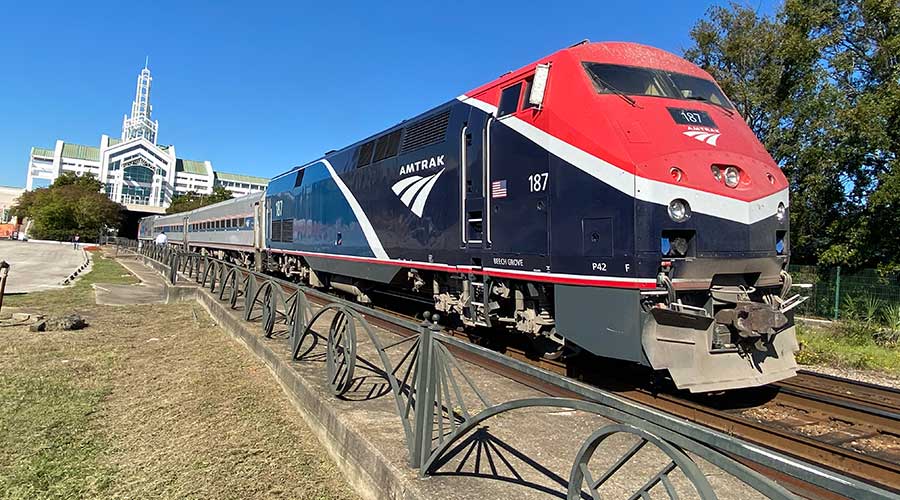 The Long-Term Implications Of Amtrak’s Gulf Coast Case
The Long-Term Implications Of Amtrak’s Gulf Coast Case Tony Hatch’s Reflections On RailTrends 2024
Tony Hatch’s Reflections On RailTrends 2024